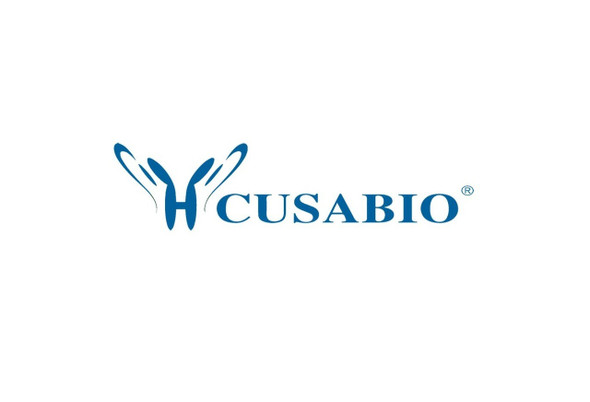Cusabio Human Recombinants
Recombinant Human Chromobox protein homolog 7 (CBX7) | CSB-YP004603HU
- SKU:
- CSB-YP004603HU
- Availability:
- 25 - 35 Working Days
Description
Recombinant Human Chromobox protein homolog 7 (CBX7) | CSB-YP004603HU | Cusabio
Alternative Name(s): CBX7; Chromobox protein homolog 7
Gene Names: CBX7
Research Areas: Transcription
Organism: Homo sapiens (Human)
AA Sequence: MELSAIGEQVFAVESIRKKRVRKGKVEYLVKWKGWPPKYSTWEPEEHILDPRLVMAYEEKEERDRASGYRKRGPKPKRLLLQRLYSMDLRSSHKAKGKEKLCFSLTCPLGSGSPEGVVKAGAPELVDKGPLVPTLPFPLRKPRKAHKYLRLSRKKFPPRGPNLESHSHRRELFLQEPPAPDVLQAAGEWEPAAQPPEEEADADLAEGPPPWTPALPSSEVTVTDITANSITVTFREAQAAEGFFRDRSGKF
Source: Yeast
Tag Info: N-terminal 6xHis-tagged
Expression Region: 1-251aa
Sequence Info: Full Length
MW: 30.3 kDa
Purity: Greater than 90% as determined by SDS-PAGE.
Relevance: Component of a Polycomb group (PcG) multiprotein PRC1-like complex, a complex class required to maintain the transcriptionally repressive state of many genes, including Hox genes, throughout development. PcG PRC1 complex acts via chromatin rodeling and modification of histones; it mediates monoubiquitination of histone H2A 'Lys-119', rendering chromatin heritably changed in its expressibility. Promotes histone H3 trimethylation at 'Lys-9' (H3K9me3). Binds to trimethylated lysine residues in histones, and possibly also other proteins. Regulator of cellular lifespan by maintaining the repression of CDKN2A, but not by inducing telomerase activity.
Reference: The DNA sequence of human chromosome 22.Dunham I., Hunt A.R., Collins J.E., Bruskiewich R., Beare D.M., Clamp M., Smink L.J., Ainscough R., Almeida J.P., Babbage A.K., Bagguley C., Bailey J., Barlow K.F., Bates K.N., Beasley O.P., Bird C.P., Blakey S.E., Bridgeman A.M. , Buck D., Burgess J., Burrill W.D., Burton J., Carder C., Carter N.P., Chen Y., Clark G., Clegg S.M., Cobley V.E., Cole C.G., Collier R.E., Connor R., Conroy D., Corby N.R., Coville G.J., Cox A.V., Davis J., Dawson E., Dhami P.D., Dockree C., Dodsworth S.J., Durbin R.M., Ellington A.G., Evans K.L., Fey J.M., Fleming K., French L., Garner A.A., Gilbert J.G.R., Goward M.E., Grafham D.V., Griffiths M.N.D., Hall C., Hall R.E., Hall-Tamlyn G., Heathcott R.W., Ho S., Holmes S., Hunt S.E., Jones M.C., Kershaw J., Kimberley A.M., King A., Laird G.K., Langford C.F., Leversha M.A., Lloyd C., Lloyd D.M., Martyn I.D., Mashreghi-Mohammadi M., Matthews L.H., Mccann O.T., Mcclay J., Mclaren S., McMurray A.A., Milne S.A., Mortimore B.J., Odell C.N., Pavitt R., Pearce A.V., Pearson D., Phillimore B.J.C.T., Phillips S.H., Plumb R.W., Ramsay H., Ramsey Y., Rogers L., Ross M.T., Scott C.E., Sehra H.K., Skuce C.D., Smalley S., Smith M.L., Soderlund C., Spragon L., Steward C.A., Sulston J.E., Swann R.M., Vaudin M., Wall M., Wallis J.M., Whiteley M.N., Willey D.L., Williams L., Williams S.A., Williamson H., Wilmer T.E., Wilming L., Wright C.L., Hubbard T., Bentley D.R., Beck S., Rogers J., Shimizu N., Minoshima S., Kawasaki K., Sasaki T., Asakawa S., Kudoh J., Shintani A., Shibuya K., Yoshizaki Y., Aoki N., Mitsuyama S., Roe B.A., Chen F., Chu L., Crabtree J., Deschamps S., Do A., Do T., Dorman A., Fang F., Fu Y., Hu P., Hua A., Kenton S., Lai H., Lao H.I., Lewis J., Lewis S., Lin S.-P., Loh P., Malaj E., Nguyen T., Pan H., Phan S., Qi S., Qian Y., Ray L., Ren Q., Shaull S., Sloan D., Song L., Wang Q., Wang Y., Wang Z., White J., Willingham D., Wu H., Yao Z., Zhan M., Zhang G., Chissoe S., Murray J., Miller N., Minx P., Fulton R., Johnson D., Bemis G., Bentley D., Bradshaw H., Bourne S., Cordes M., Du Z., Fulton L., Goela D., Graves T., Hawkins J., Hinds K., Kemp K., Latreille P., Layman D., Ozersky P., Rohlfing T., Scheet P., Walker C., Wamsley A., Wohldmann P., Pepin K., Nelson J., Korf I., Bedell J.A., Hillier L.W., Mardis E., Waterston R., Wilson R., Emanuel B.S., Shaikh T., Kurahashi H., Saitta S., Budarf M.L., McDermid H.E., Johnson A., Wong A.C.C., Morrow B.E., Edelmann L., Kim U.J., Shizuya H., Simon M.I., Dumanski J.P., Peyrard M., Kedra D., Seroussi E., Fransson I., Tapia I., Bruder C.E., O'Brien K.P., Wilkinson P., Bodenteich A., Hartman K., Hu X., Khan A.S., Lane L., Tilahun Y., Wright H.Nature 402:489-495(1999)
Storage: The shelf life is related to many factors, storage state, buffer ingredients, storage temperature and the stability of the protein itself. Generally, the shelf life of liquid form is 6 months at -20?/-80?. The shelf life of lyophilized form is 12 months at -20?/-80?.
Notes: Repeated freezing and thawing is not recommended. Store working aliquots at 4? for up to one week.
Function: Component of a Polycomb group (PcG) multiprotein PRC1-like complex, a complex class required to maintain the transcriptionally repressive state of many genes, including Hox genes, throughout development. PcG PRC1 complex acts via chromatin remodeling and modification of histones; it mediates monoubiquitination of histone H2A 'Lys-119', rendering chromatin heritably changed in its expressibility. Promotes histone H3 trimethylation at 'Lys-9' (H3K9me3). Binds to trimethylated lysine residues in histones, and possibly also other proteins. Regulator of cellular lifespan by maintaining the repression of CDKN2A, but not by inducing telomerase activity.
Involvement in disease:
Subcellular Location: Nucleus
Protein Families:
Tissue Specificity:
Paythway:
Form: Liquid or Lyophilized powder
Buffer: If the delivery form is liquid, the default storage buffer is Tris/PBS-based buffer, 5%-50% glycerol. If the delivery form is lyophilized powder, the buffer before lyophilization is Tris/PBS-based buffer, 6% Trehalose, pH 8.0.
Reconstitution: We recommend that this vial be briefly centrifuged prior to opening to bring the contents to the bottom. Please reconstitute protein in deionized sterile water to a concentration of 0.1-1.0 mg/mL.We recommend to add 5-50% of glycerol (final concentration) and aliquot for long-term storage at -20?/-80?. Our default final concentration of glycerol is 50%. Customers could use it as reference.
Uniprot ID: O95931
HGNC Database Link: HGNC
UniGene Database Link: UniGene
KEGG Database Link: KEGG
STRING Database Link: STRING
OMIM Database Link: OMIM










